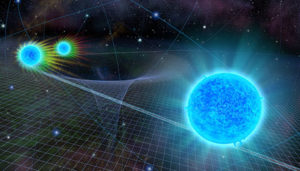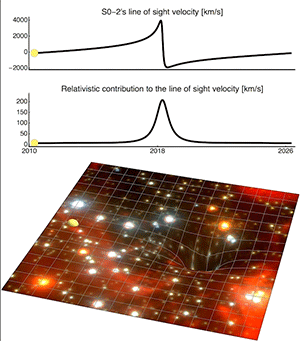Galactic Center Gravity Test Confirmed – Sky & Telescope
A second team of astronomers has now confirmed the light from a star passing near our galaxy’s central black hole behaved as predicted by Einstein’s theory of gravity.

Artist’s concept of the star S0-2 going through stages of its pass around the Milky Way’s central black hole (deep in the pit). S0-2 actually dips into the gravitational well when at its closest, and its light shifts from blue, to green, to red (indicated by the light beams).
Credit: Nicolle R. Fuller / NSF
In May 2018, the island of Hawai‘i shook in travail. Lava poured from a rift in the side of the volcano Kilauea, and two earthquakes rattled people and buildings, triggering the evacuation not only of houses in the lava’s path but also the staff at the neighboring summit of Maunakea and the Keck Observatory’s headquarters in Waimea.
Although the mountain was losing its cool, astronomer Andrea Ghez (University of California, Los Angeles) wasn’t. She and her team had spent more than two decades using the Keck telescopes and other facilities to watch stars loop around Sgr A*, the black hole in our galaxy’s center. That month a big, bluish star was whizzing through its closest pass of the leviathan, at a fair fraction of the speed of light. The astronomers had carefully calculated exactly which days were most important for their observations, and Ghez knew they could afford to lose one to the volcano — which they did.
Ghez’s team is one of two — the other led by Reinhard Genzel (Max Planck Institute for Extraterrestrial Physics, Germany) — that have followed the stars in the galactic center since the 1990s. These stars are an oddball group of large, young suns, whizzing through a region where star formation should be impossible.
Astronomers care about these stars for many reasons, but the most recent observing runs focused on a single member of the troupe and what it can tell us about gravity. Called S2 by the German team and S0-2 by the American one, the star that made its mad dash in 2018 comes closer to Sgr A* than any other star we’ve detected — about 120 astronomical units, or four times Neptune’s distance from the Sun. That’s so close that the star zips inside the edge of the dip the black hole makes in the fabric of spacetime, like a fearless cosmic skateboarder going sideways on a ramp. As S2 dives in, its photons have to climb out in order to reach us. The climb robs them of energy, which shifts them to longer, redder wavelengths.
This relativistic redshift doesn’t happen in Newtonian gravity. Mind you, there is a redshift in Newton’s version, but it’s only due to the star moving along our line of sight. Einstein’s general theory of relativity (GR) tacks on an extra shift that’s roughly one-tenth as big — not the easiest thing to see when you’re tracking stars 26,000 light-years away, all crowded into your field of view like dancing polka dots.
But last July, Genzel and his colleagues announced that they had finally detected this relativistic redshift, using the superb capabilities of the Gravity interferometric instrument at the Very Large Telescope in Chile to watch S2 skirt past the black hole.
Before going public, Genzel asked Ghez if she’d like to do a joint announcement of both groups’ results. But Ghez demurred. There were three key points in S2’s closest approach: first in April, when the star’s motion away from us along our line of sight escalated, then turned and plunged back toward us; second, in mid-May, when the star came closest to the black hole as seen in the plane of the sky; third, in September, when the star pulled out of its headlong rush toward us and slowed. Ghez wanted to observe the star’s last turn before she analyzed her data.

As the star S0-2 nears our galaxy’s supermassive black hole (orbit exaggerated), the light it emits has to climb out of the gravitational potential well, losing energy. This process reddens the light. The star’s motion along our ling of sight also shifts the light’s wavelengths, and so astronomers measure both shifts in km/s.
Credit: Aurelien Hees / Keck UCLA Galactic Center Group
Those data, scrupulously checked for inconsistencies, now appear July 25th in Science. The analysis by Ghez, deputy director Tuan Do (also UCLA), and their colleagues confirms that of the Gravity Collaboration, clearly showing a relativistic redshift of about 200 km/s and ruling out Newtonian gravity. (Genzel’s group has also published a follow-up paper including their observations through September 2018.)
Although a confirmation result often has trouble grabbing headlines, this is science at its best: two independent teams, using different telescopes and instruments and analysis methods, finding the same thing.
Well, not quite the same thing. What has both teams puzzled is that, although they see the same redshift, other, more prosaic parameters they calculate from their observations don’t quite match. For example, their measurements of Sgr A*’s distance differ by some 600 light-years. “The two results should agree, we’re looking at the same black hole!” Ghez says.
The discrepancies are “a very interesting question,” Genzel agrees. It’s unclear what about the teams’ distinct methods of measurement and analysis leads to them. Since the researchers construct their frameworks of S2’s orbit using data spanning multiple decades and instrument capabilities, there are a lot of aspects to check.
While the discrepancies aren’t an issue for the redshift measurement, whatever underlies the small differences will matter for the next step in using the galactic center’s stars to test GR: looking for precession. Due to the vagaries of warped spacetime, S2 shouldn’t come back to the exact same spot when it completes an orbit. Instead, it’ll precess, drawing out a Spirograph-like pattern around the black hole as it finishes each 16-year lap. Explaining how much Mercury’s orbit precesses around the Sun was one of the original selling points for GR; now, astronomers want to see if the physics works the same way in the most extreme gravitational environments we can probe. Detecting the precession is a far more challenging measurement that ups the ante on precision. The teams may have results on that front within a year or so.
References:
T. Do et al. “Relativistic Redshift of the Star S0-2 Orbiting the Galactic Center Supermassive Black Hole.” Science. August 16, 2019 (announced July 25, 2019).
Gravity Collaboration. “Detection of the Gravitational Redshift in the Orbit of the Star S2 near the Galactic Centre Massive Black Hole.” Astronomy & Astrophysics Letters. July 2018.
Gravity Collaboration. “A Geometric Distance Measurement to the Galactic Center Black Hole with 0.3% Uncertainty.” Astronomy & Astrophysics Letters. May 2019.
Read more about S2 and its brethren in our September 2018 issue. You can also watch a video about the UCLA team’s project.





